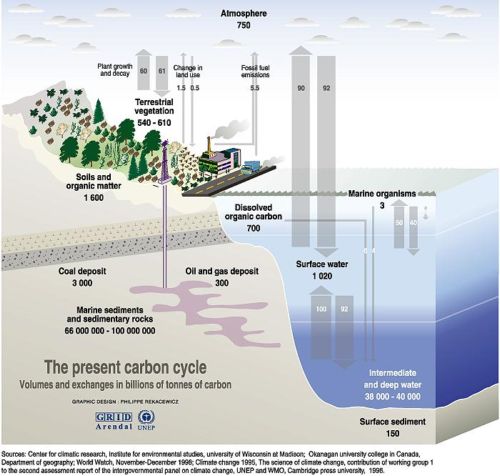Life on earth is made possible by energy from the sun, which arrives mainly in the form of visible light. About 30 per cent of sunlight is scattered back into space by the outer atmosphere, but the rest reaches the earth's surface, which reflects it in the form of a calmer, more slow-moving type of energy called infrared radiation. (This is the sort of heat thrown off by an electric grill before the bars begin to grow red.) Infrared radiation is carried slowly aloft by air currents, and its eventual escape into space is delayed by greenhouse gases such as water vapour, carbon dioxide, ozone, and methane.
Greenhouse gases make up only about 1 per cent of the atmosphere, but they act like a blanket around the earth, or like the glass roof of a greenhouse -- they trap heat and keep the planet some 30 degrees C warmer than it would be otherwise.
Human activities are making the blanket "thicker" -- the natural levels of these gases are being supplemented by emissions of carbon dioxide from the burning of coal, oil, and natural gas; by additional methane and nitrous oxide produced by farming activities and changes in land use; and by several long-lived industrial gases that do not occur naturally.
These changes are happening at unprecedented speed. If emissions continue to grow at current rates, it is almost certain that atmospheric levels of carbon dioxide will double from pre-industrial levels during the 21st century. It is possible they will triple.
The result, known as the "enhanced greenhouse effect," is a warming of the earth's surface and lower atmosphere. Computer climate models estimate that the average global temperature will rise by 1.4 to 5.8 degrees C by the year 2100. A temperature increase of .6 degrees C occurred last century.
Even a small rise in temperature will be accompanied by changes in climate -- in such things as cloud cover, precipitation, wind patterns, and the duration of seasons. In a world that is crowded and under stress, millions of people depend on weather patterns, such as monsoon rains, to continue as they have in the past. Changes, at a minimum, will be difficult and disruptive.
Carbon dioxide is responsible for over 60 per cent of the "enhanced greenhouse effect." Humans are burning coal, oil, and natural gas at a rate that is much, much faster than the speed at which these fossil fuels were created. This is releasing the carbon stored in the fuels into the atmosphere and upsetting the carbon cycle, the millennia-old, precisely balanced system by which carbon is exchanged between the air, the oceans, and land vegetation. Currently, atmospheric levels of carbon dioxide are rising by over 10 per cent every 20 years.

Fossil fuel use is boosting atmospheric levels of carbon, upsetting an age-old balance.
Some climate change is now inevitable because of past and current emissions. The climate does not respond immediately to external changes, but after 150 years of industrialization, global warming has momentum, and it will continue to affect the earth's natural systems for hundreds of years even if greenhouse gas emissions are reduced and atmospheric levels stop rising.
Source: http://unfccc.int/essential_background/feeling_the_heat/items/2903.php
